Marulanda J.M. (ed.) Electronic Properties of Carbon Nanotubes
Подождите немного. Документ загружается.


Single Wall Carbon Nanotubes in the Presence of Vacancies and Related Energy Gaps
605
2. Electronic density of states
The electronic density of states (DOS) is the number of available electrons for a given energy
interval. DOS of a crystalline solid, which dramatically depends on the dimension of the
system, is fundamental in describing the electronic transport, electrical, optical, thermal, and
mechanical properties of the solid [Lu, Pan, 2004, Zhu et al., 1933]. The density of states
enters in the experimental study, the application of the electronic properties, and
computation of some useful quantities of a system such as electrical resistance and
conductance.The helicity or local symmetry of CNTs, along with the diameter which
determines the size of the repeating structural unit introduces significant changes in the
electronic density of states, and hence provides a unique electronic character for the
nanotubes [Hansson et al., 2000]. The DOS of semiconducting carbon nanotubes near the
Fermi level located at E=0 is zero, but the DOS of metallic nanotubes near the E=0 is non-
zero. In addition, the DOS of zigzag and armchair carbon nanotubes shows van Hove
singularities whose numbers are consistent with the number of hexagons around the
circumference of the (n, m) nanotube.
3. Synthesis methods of carbon nanotubes
Generally, three techniques are being used to produce carbon nanotubes including the
electric arc discharge, the laser ablation, and the chemical vapor deposition (CVD). In each
of techniques it is possible we have some vacancies in produced carbon nanotube structures.
In the next sections, the method of evaluating the effects of vacancies in the DOS of these
structures are discussed, here a brief explanation on Synthesis methods of carbon nanotubes
is presented.
3.1 Electric arc discharge
The electric arc discharge method as one of the first methods to produce CNTs, employs a
chamber filled with an inert gas, two electrodes of pure graphite rods, and a DC power
supply. A current of about 50–100A passed though the electrodes causes carbon atoms are
vaporized from the graphite anode in the form of crystallites and are deposited on the
cathode electrode in the form of small carbon clusters. Next, these carbon clusters rearrange
themselves into a tubular shape forming the MWCNTs, which drift toward the cathode and
deposit on its surface. MWNTs are obtained when a pure graphite target is used and
SWNTs when the target is a mixture of graphite and metallic catalysts such as Ni-Co or Ni-Y
mixtures. However a cylindrical and homogenous deposit forms on the cathode with a quite
high rate, the presence of “unwanted” graphite crystallites that do not form into nanotubes
is the limiting factor for high yield CNTs [Peter, Harris, 2009, Dervish et al., 2009].
3.2 Laser ablation
The laser ablation or the evaporation method was introduced by Smalley and his coworkers
in 1995. In this technique, a powerful laser is used to ablate a carbon target in an inert
atmosphere at low pressure. The laser beam incident results in evaporating carbon from the
graphite. The carrier gas sweeps the carbon atoms from the high-temperature zone to a cold
copper collector on which they condense into nanotubes. In order to generate SWCNTs
using the laser ablation technique, it is necessary to impregnate the graphite target with
transition metal catalysts. It is experimentally found that the SWCNT growth time in this

Electronic Properties of Carbon Nanotubes
606
technique is only a few milliseconds long. Generally, along with SWCNTs and MWCNTs,
fullerenes, amorphous carbon, and other carbon by-products are produced while using the
laser ablation technique. MWCNTs produced by this method have a number of layers
varying from 4 to 24 and an inner diameter ranging between 1.5 and 3.5nm. Unfortunately,
the laser ablation methode is very expensive because it involves high-purity graphite rods
and high power lasers [Dervish, 2009; Loiseau et al., 2006].
3.3 Chemical vapor deposition (CVD)
Chemical vapor deposition (CVD) is a relatively slow method that produces long CNTs
quantities. In this method, CNTs are synthesized by taking hydrocarbons (the commonly
used sources are methane, ethylene, and acetylene) and using an energy source, such as
electron beam or resistive heating, to impart energy to them. At first, the energy source
heats The hydrocarbon at high temperatures, typically between 700 and 1000 ˚C, in the
presence of catalytic systems (usually a first-row transition metal such as Ni, Fe, or, Co) and
breaks it into hydrogen and carbon. Then, carbon atoms dissolve and diffuse into the metal
surface and rearrange themselves into a network containing hexagons of carbon atoms and
finally precipitate out in the form of CNTs. Higher yields of MWCNTs and SWCNTs are
produced when the catalytic system is composed of two different metals. CNTs produced
with the CVD method can be scaled up for large scale and high-quality at a relatively low
cost. In addition, the growth of CNTs can be controlled by adjusting the reaction parameters
such as the catalyst system, temperature, type of hydrocarbon, and the flow rate of the
gases. Another advantage of the CVD method is that it enables the deposition of CNTs on
pre-designed lithographic structures, producing ordered arrays of CNTs [Dervish, 2009].
4. Coherent potential approximation (CPA)
In 1963, Davis, Langer and Klauder introduced the coherent potential approximation to
solve the single-site scattering problem [Yoyozawa,1968]. Then, several authors [Onodera &
Yoyozawa, 1968; Soven 1960] used it to calculate DOS in a disordered substitutional alloy in
which random elements have short-range potential. In this approximation, random
disordered system would be replaced by an effective ordered system which is chosen so that
the average of the scattering amplitudes for the actual atoms placed in the effective medium
vanishes. Besides, according to this theory, the behavior of a single site or cell specifies the
manner of the whole system.
To calculate the averaged Green’s function, the single electron Green’s function can be
expressed as follows,
1
() ,G
H
(1)
here H is the Hamiltonian of the system. In order to use the multiple scattering theory, H is
better to divide into the unperturbed or reference Hamiltonian K and the perturbation term
v as,
.
HvK
(2)
Also, the reference Green’s function P is written as,

Single Wall Carbon Nanotubes in the Presence of Vacancies and Related Energy Gaps
607
1
() ,
P
K
(3)
Using P, the t scattering matrix associated with the atom n in the effective medium becomes,
1
1.
nn n
tv pv
(4)
Next, the average of the total scattering matrix T related to the G given by
,G P PTP
(5)
Can be expressed as
(1 ) .
nn m
nn mn
TT tPT
(6)
On the other hand, the effective Hamiltonian can be defined as,
1
(1 ) ,
eff
HKT pT
(7)
or
1
(1 ) .
eff n n
n
HK t Pt
(8)
Within the single site approximation, the condition of
n
t
=0 for any n leads to
0Tand as a result GP
. It means that additional scattering due to a real atom in
the CPA environment is averagely zero. Thus, average scattering caused by an impurity is
equal to the scattering caused by the environment. In this condition, the effective
Hamiltonian is equal to K. Since the K is not exactly specified, it can be computed by the self
consistent method.
5. Infinite zigzag single wall carbon nanotubes in the presence of vacancies
The single-wall carbon nanotube in tight bonding model is described by [Economou, 2006,
Heyd, 1997],
,
ˆ
i
ij
iij
Hi i i
j
, (9)
where α and β refer to the A or B sublattices, ε
i
α
refer to on-site energies, and γ
i,j
αβ
is the
hopping integral between sites i and j in A or B sublattices. Since we consider the nearest
neighbor interaction, the hopping integrals γ
i,j
AA
and γ
i,j
BB
take zero values while the off-
diagonal hopping integrals, γ
i,j
AB
and γ
i,j
BA
, take a constant value γ
0
. The on-site energies
associated with the two different sites A and B of a graphene sheet have the same values.
We neglect the effect of wall curvature in Hamiltonian. The complete set of
i
is the
atomic wave functions localized on site i. in A or B sublattices. The Bloch wave functions of
the tube are given by [Heyd, 1997],
.
1
j
i
j
ej
N
KR
XK X (10)
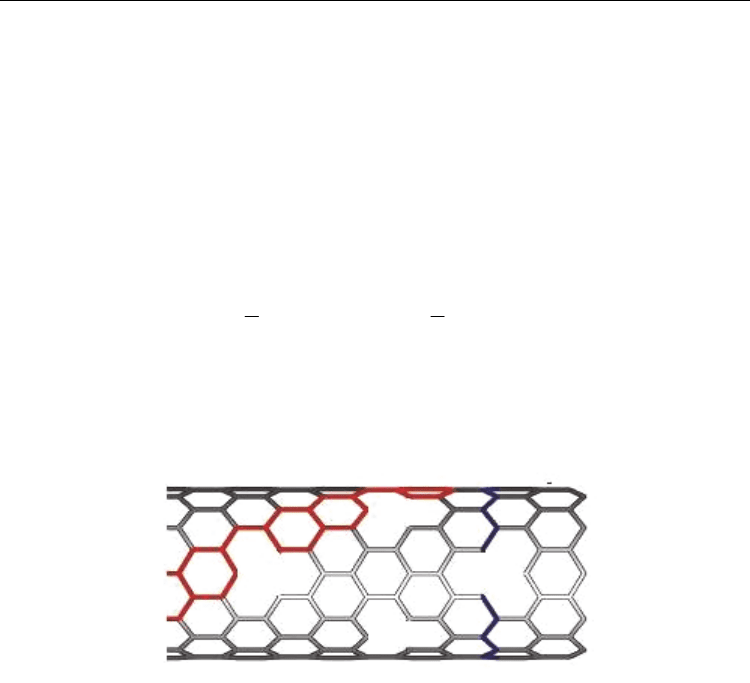
Electronic Properties of Carbon Nanotubes
608
Here, we just consider the electronic properties of π- bonds since every carbon atom has four
valance electrons, one 2s electron and three 2p electrons and the overlap between the p
z
wave function with the s or the p
x
and p
y
electrons is strictly zero, we can treat the p
z
electrons, form π-bonds of graphene, independently of the other valance electrons. There are
also some high symmetric points in Brillouin zone which are located near the Fermi level, so
many of the electronic properties of SWCNTs are related to this bonds [Wallace, 1972]. The
associated Green’s function operator can be described as [Economou, 2006],
1
ˆ
ˆˆ
GIzH
(11)
So the local density of states can be written as
()
11
ˆˆ
() Im ( ) = Im ( )
m
m
DOSE TrGEis G Eis
(12)
where m, the number of allowed band, is obtained by the half number of at0oms in the first
Brillouin zone and s is an infinitesimal number for convergence. We present a schematic plot
of our system which is a typical zigzag SWCNT in the presence of vacancies as
substitutional disorders in Fig. 1.
Fig. 1. The schematic plot of zigzag single-wall carbon nanotube with random vacancies
On the other hand, we suppose in the presence of vacancies the structure remain the same
as in the absence of them except that some carbon atoms are replaced by holes.
By considering this assumption, in order to investigate effects of vacancy percentage on
density of states of SWCNTs, we use coherent potential approximation. As mentioned
before, in CPA, the Green’s function for a system of scatterers can be written in operator
notation as [Györffy, 1972; Korringa & Mills, 1972]:
GGGTG
(13)
where
G
is the Green’s function of real nanotube and G is the average effective Green’s
function and T is the total scattering matrix of the system. The scattering matrix of the
system may be written as [Györffy, 1972]:
,
,1 ,1
NN
ii
j
ik
j
ij ij k j
Tt TGt
, (14)

Single Wall Carbon Nanotubes in the Presence of Vacancies and Related Energy Gaps
609
where T
ik
is the scattering-path operator which have been introduced by Györffy for the first
time and t
i
is the t matrix that describes the scattering from the potential on the i-th site
which can be written as,
1
(1 )
ii i
tV GV
, (15)
Here, V
i
is the extra potential that is caused the scattering i-th site with respect to an
effective medium. The effective medium is introduced by the self energy ξ which can be
determined by T = 0. Using the CPA, we impose the condition that for any site t
i
= 0
which means the extra effective scattering due to the atom at site i vanishes and the
following self-consistent equations can be achieved [Datta & Thakur, 1994],
()
2
()
0
.( )
()
2
,
() lim
2
()
ij
m
mband
s
i
m
ij
ij
Eis
GEis
N
Eis e
KR R
(16)
and
1
2
()
() ()2 () ()
11
()
2()4() () ()
m
cc
mmmm
Eis
G E is G E is G E is G E is
, (17)
where ε
c
is the on-site energy of carbon atoms, η is the vacancy percentage, and ξ
(m)
is the
self-energy.
By using the method described above, we investigate the density of states of zigzag (12, 0)
SWCNT. All calculations are performed at zero temperature and we use ε
c
= 1 eV and γ
0
=
2.75 eV. The density of states of (12, 0) SWCNT as a function of energy in units of γ
0
are
depicted in Fig. 2 for η = 0. The energy gap of (12, 0) SWCNT in the absence of vacancy, η =
0, is E
g
= 0.02 eV that is in agreement with local density approximation (LDA) calculations
[Miyake & Saito,1998]. Saito et al. showed that by just using the π tight-binding method
there is no gap in the band structure, but this is not shown in our calculations. The
associated experimental probes showed that the energy gap of (12, 0) SWCNT is 0.04±0.004
eV [Ouyang et al., 2001]. The energy gap of three zigzag SWCNTs is compared in Table 1. In
regard to Table 1, by increasing SWCNT’s index or increasing the diameter of SWCNTs, our
results approach to the experimental results of Min Ouyang et al. The difference is as a
result of neglecting the effect of wall curvature in Hamiltonian as mentioned before.
(n , 0) SWCNT
E
g
(eV) E
g
(eV) from Ref.
(9, 0) 0.022 0.080±0.005
(12, 0) 0.02 0.04±0.004
(15, 0) 0.02 0.029±0.004
Table 1. Comparison between our computational energy gaps with experimental energy
gaps from Ref. [Ouyang, 2001 ].
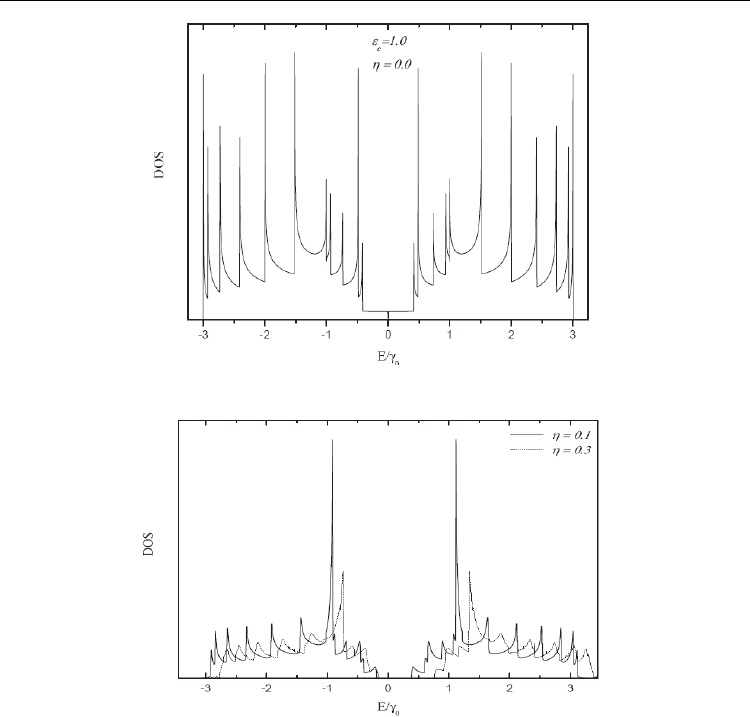
Electronic Properties of Carbon Nanotubes
610
Fig. 2. Density of states for a pure (12, 0) SWCNT
Fig. 3. Density of states for (12, 0) SWCNT in the presence of vacancy for η = 0.1(Solid line),
η = 0.3 (Dot line).
The band gap opening is occurred, as it is depicted in Fig. 3 for η = 0.1, 0.3. According to this
figure, the maximum value of the peak of one-dimensional (1D) Van Hove singularities in
greater values of vacancy concentrations become less, also at greater values of vacancy
concentrations, SWCNTs lose their 1D characteristics and become similar to a kind of 2D
disordered graphene sheet. In realistic, by increasing the value of vacancy concentrations,
the freedom of valance electrons becomes higher, so we expect the feature of 2D structure.
Also there is a small shift in DOS because of influence of vacancy percentage on the on-site
energy of carbon atoms. By increasing the value of vacancy concentrations, as it is depicted
in Fig. 3, the number of peaks becomes less. In addition, by increasing vacancy percentage
on (12, 0) SWCNT the energy gap is increased. This fact can be realized by considering the
broken lattice symmetries. By breaking symmetry, the valance electrons do not obey Bloch
order, so multiple scattering is occurred, then we have gap opening and metallic SWCNTs is
changed to semi-metallic SWCNTs.
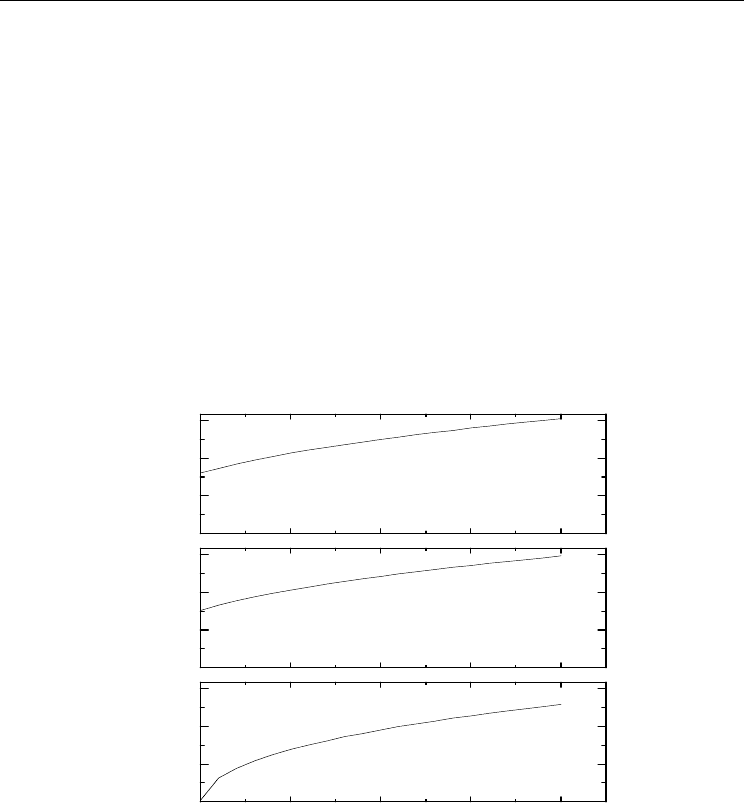
Single Wall Carbon Nanotubes in the Presence of Vacancies and Related Energy Gaps
611
The variations of the energy gap versus vacancy percentage is shown in Fig. 4(a), 4(b), and
4(c) for (7, 0), (8, 0), (12, 0) SWCNTs, respectively. The results show that, by increasing
vacancy percentage for all three types of zigzag SWCNTs, the energy gap is also increased.
This treatment is realized by multiple scattering that is occurred in vacancies. Moreover, the
slopes of the graphs for the small values of vacancy percentages are not the same and at low
vacancy percentages, the growth of gap opening versus vacancy percentage for (12, 0)
SWCNT is higher than the other ones. Also by considering Fig 4(a), 4(b), and 4(c), we realize
that for η = 0, the energy gaps of (7, 0), (8, 0), and (12, 0) SWCNTs, are 1.19, 1.12, and 0.02 eV,
respectively. Furthermore, in special vacancy percentage, the energy gap of (7, 0) SWCNT is
higher than the other ones. We can realize this result by considering the number of carbon
atoms in the unit cell of SWCNTs and the diameter of SWCNTs. The number of carbon
atoms in the unit cell of (n, 0) SWCNTs, q, is derived by q = 2n, so the number of carbon
atoms in the unit cell of (7, 0), (8, 0), (12, 0) SWCNTs are 14, 16, and 24, respectively. Thus
the number of carbon atoms and diameter of (7, 0) SWCNT is less than the other ones, so in
special vacancy percentage, the affects of breaking symmetries and backscattering are more
dominant respect to the others.
0.00 0.05 0.10 0.15 0.20
0.0
0.3
0.6
0.9
(c)
(12,0)
0.0
0.3
0.6
0.9
(b)
(8 ,0 )
E
g
(eV)
0.0
0.3
0.6
0.9
(a)
(7 ,0 )
Fig. 4. The energy gap versus vacancy percentage for (a) (7, 0) SWCNT, (b) (8, 0) SWCNT, (c)
(12, 0) SWCNT.
The energy gap of different kinds of zigzag SWCNTs as a function of nanotube index n for
three different values of vacancy percentage 0, 0.01, and 0.15 is displayed in Fig. 5. This
figure shows that for all zigzag SWCNTs the energy gap is also increased by increasing
vacancy percentage. Thus metallic to semi-metallic transition is occurred for metallic zigzag
SWCNTs that is considered by Yuchen Ma et al. [Yuchen, 2004]
by using spin-polarized
density functional theory. They investigated the influence of configuration mono-vacancy
on electronic properties of zigzag SWCNTs and showed for six kinds of zigzag SWCNTs
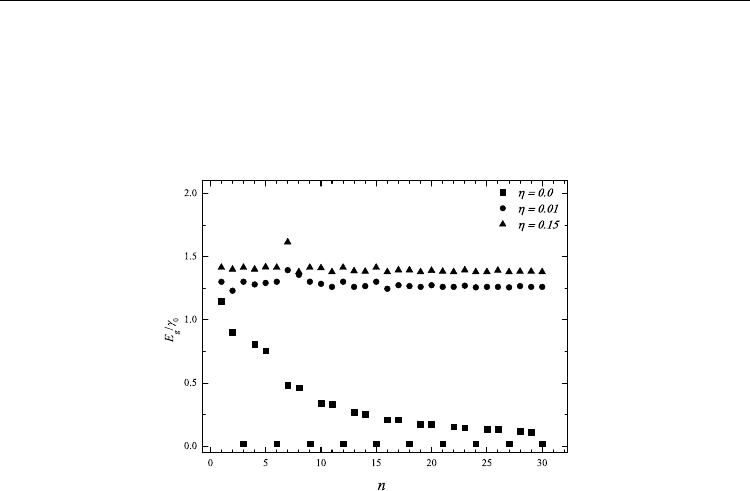
Electronic Properties of Carbon Nanotubes
612
with n = 5… 10, the vacancies can change the electronic properties of SWCNTs, converting
some metallic nanotubes to semiconductors. Also they found that only (5, 0) SWCNT is
always semiconductor by changing configuration of mono-vacancy and here according to
Fig. 5, we see that by increasing the value of vacancy percentage, (5, 0) SWCNT remain
semiconductor. However, this treatment also occurs for all kinds of semiconductor zigzag
SWCNTs such as (7, 0), (10, 0), and so on.
Fig. 5. The energy gap versus the zigzag nanotube index for three values of vacancy
percentage η = 0.0, 0.01, 0.15.
In summary by using CPA method, effects of vacancy percentage on the energy gap of
zigzag SWCNTs were investigated. It is found that the energy gap of pure (12, 0) SWCNT is
0.02 eV that is in agreement with LDA calculations and the experimental work of M.
Ouyang et al., Also by increasing the concentration of vacancies, the energy gap is increased
and a metallic to semi-metallic transition is occurred for metallic (n, 0) zigzag SWCNTs. For
semiconductor zigzag SWCNTs any transition does not appear. As mentioned before, at
large enough vacancy concentrations, the SWCNTs lose their 1D characteristics and the
associated density of states become similar to a kind of 2D disordered graphene sheet. In
addition, our calculations show that the maximum energy gap is increased by decreasing
zigzag nanotube index (n) which is due to decreasing diameter of SWCNT and therefore
increasing the effect of vacancies in back scattering. Therefore by creation vacancies in the
structure of zigzag SWCNTs the metallic to semi-metallic transition are occurred. In
addition, it is possible to achieve the special semiconductor SWCNT with a predetermined
energy gap in order to use in semiconductor industry.
6. Semiconductor finite zigzag carbon nanotubes in the presence of
vacancies
Carbon nanotubes show promise for applications in future electronic systems, and the
performance of carbon nanotube devices, in particular, has been rapidly advancing.
Semiconducting nanotubes are suitable for transistors. In order to correctly treat carbon
nanotube transistors, strong quantum confinement around the tube circumferential
direction, quantum tunneling through Schottky barriers at the metal/nanotube contacts,
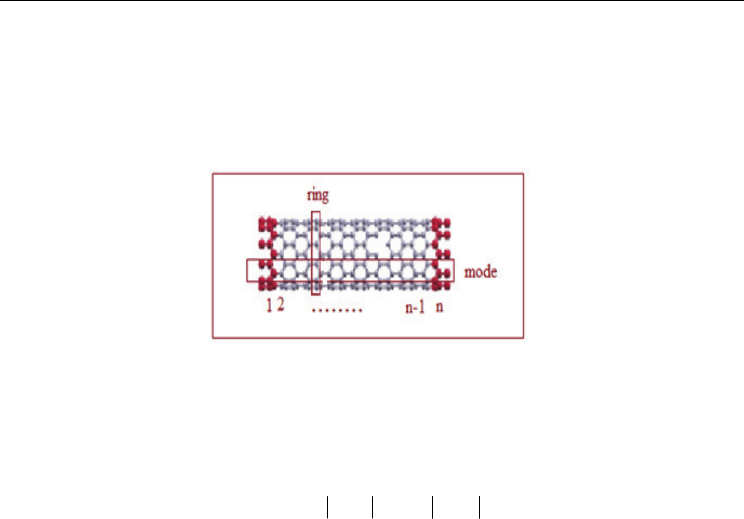
Single Wall Carbon Nanotubes in the Presence of Vacancies and Related Energy Gaps
613
and quantum tunneling and reflection at barriers in nanotube channel need to be considered
by the non-equilibrium Green’s function (NEGF) formalism. We study the density of states
of (n, 0) carbon nanotubes in which an atom has been removed to produce a
vacancy[Faizabadi et al.,2009](Fig 6). Vacancy is one of the most common defects in carbon
nanotubes and affects the physical properties of them. The on-site energy of the vacancy
element is equaled high value, essentially repelling the carriers from that particular site.
Fig. 6. The schematic of a finite zigzag carbon nanotube in presence a single vacancy. The
modes are aligned along the carbon nanotube axis and rings that are around the cylindrical
circumference.
Our system consists of a carbon nanotube that coupled to the left L and right R lead
described by the following Hamiltonian
,
iij
iij
Hiiti
j
(18)
where,
i
E is the on-site energy for each carbon atom in the carbon nanotube and is the
hopping between the atomic sites which are supposed to be non zero for the nearest
neighbors. In this model there are orthogonal basis, corresponding to a spherically
symmetric local orbital at each atomic site in the system.
The total Hamiltonian for a system consist of a finite carbon nanotube which is connected
into two leads, the left and right ones is
LRC
HH H H
(19)
where,
L(R)
H describes the Hamiltonian for left and right leads.
C
H refers to the
Hamiltonian for central region. An effective method to describe scattering and transport is
the Green’s function that is determined by the equation
r,a
C
Eiη IHG I
(20)
here, r and a refer to retarded and advanced Green’s function. For an isolated non
interacting system the Green function is obtained after the matrix inversion.
The Green function coupled to the leads is determined by the expression
r1
CCLR
GE [Eiη IH Σ Σ ]
(21)
where,
L,R
Σ is called self-energy that describe the interaction between leads and system
†
L(R) SL(R) L(R)C
LRC
Σ E τ g τ
(22)
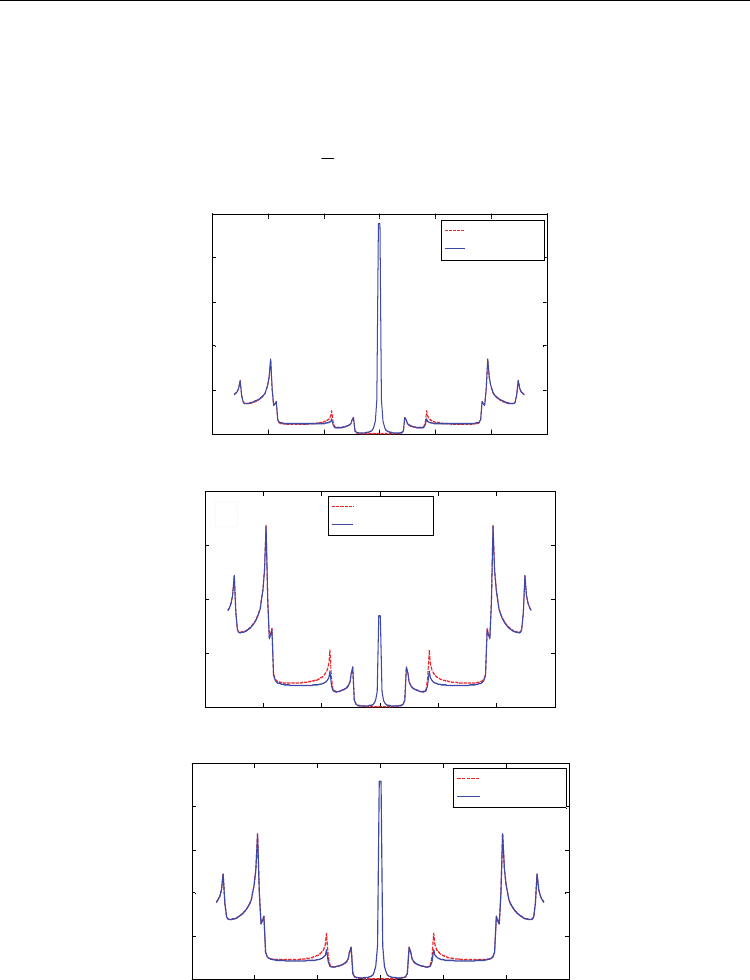
Electronic Properties of Carbon Nanotubes
614
where,
SL(R)
g is the surface green function of the decoupled left and right leads that is
calculated in the absence of the scattering region and different from the
r
C
GE.
The density of states (DOS) as a function of the incident electron energy for a carbon
nanotube is [Datta,1995]
r
C
1
DOS Im Trace G E
π
(23)
-3 -2 -1 0 1 2 3
0
10
20
30
40
50
DOS(arb.units)
Energy(eV)
perfect CNT
single Vacancy
a)
-3 -2 -1 0 1 2 3
0
5
10
15
20
DOS(arb.units)
Energy(eV)
perfect CNT
single vacancy
b)
-3 -2 -1 0 1 2 3
0
5
10
15
20
25
DOS(arb.units)
Energy(eV)
perfect CNT
single vacancy
c)
Fig. 7. The density of states of finite zigzag carbon nanotubes (11,0) in presence of the single
vacancy in a: 2
th
ring b: 3
th
ring c: 4
th
ring of 4
th
mode
